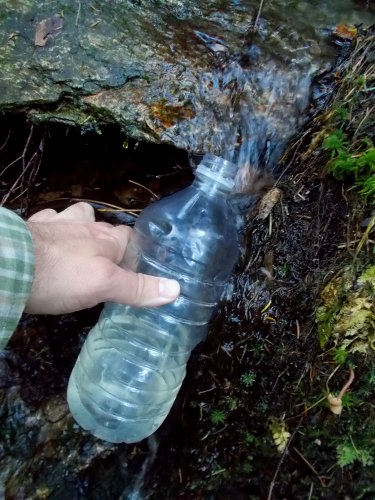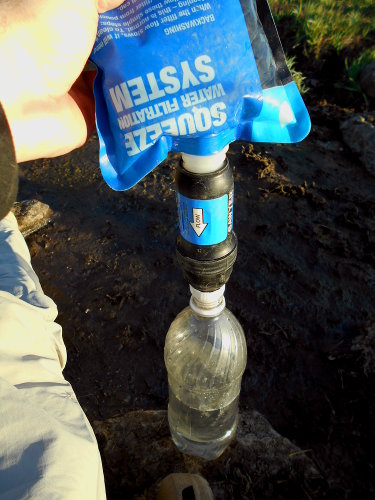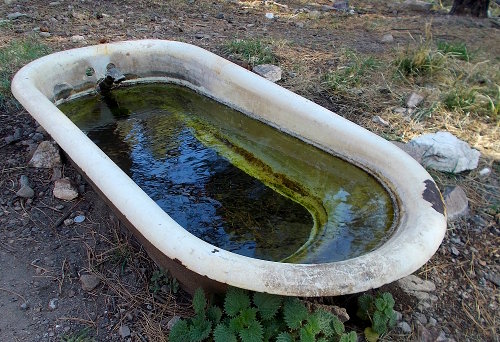Portable Water Treatment Options
We like backpacking and this website was created for backpackers—but the information here is applicable to anyone with a thirst for travel. Whether you’re in the backcountry or a third-world country with iffy water supplies, the number one consideration for filters and purifiers is that they must be portable. Small, cheap, lightweight and effectiveness are all important, but if you can’t take it with you, it’s useless.
You’ll find a wide range of suitable products and each have their advantages and disadvantages. So let’s consider our options.
Don’t Treat Water—at all!

If you’ve followed along since our page about water myths and facts, you’ll know that the dangers of backcountry water are often overstated while the benefits of water treatment are often overrated. So as blasphemous as it might seem, one option is simply not to treat your water at all! I’ve thru-hiked the Appalachian Trail (twice!) and the Pacific Crest Trail (as well as many other shorter trails) without treating water and never got sick. It took about 15,000 miles of hiking before I succummed to my first (and so far only) water-borne illness.
Before considering this option, however, know the type of area you’ll be traveling through and the likelihood of water being contaminated, and consider how much risk you’re willing to take on. I’ve also thru-hiked the Arizona Trail and Florida Trail, and I definitely treated that water! I’ll take my chances with a high-mountain stream, but I draw the line when I have to share water with cattle and their prolific amounts of poop!
Although I didn’t treat water on the AT and PCT, I still carried a small vial of iodine tablets—just in case I had to depend on water that I felt was particularly risky. You might consider a backup treatment option as well... just in case!
If the idea of not treating your water sounds scary but you find the idea tempting, you might try starting small. Start with pure, good-flowing, high-mountain springs. See how you and your body handles it. If all goes well and you get comfortable with drinking the untreated water, expand to clean, high-mountain streams.
If you don’t treat your water, it’s absolutely essential that you learn how to identify good and bad water sources and then manage your water responsibly. It’s your only protection from water-borne illnesses!
And just to be 100% clear, we cannot and do not guarantee you won’t get sick drinking untreated water. Treating water will always make water safer to drink (assuming you follow all directions correctly, of course). We drink untreated water regularly, but we’re willing to take that chance when we believe the risk is minimal—but the risk is still there! If you get sick, you have nobody but yourself to blame.
Pros
- Free!
- Weighs nothing!
- Takes up no space!
- Fast!
Cons
- Least reliable treatment option. It won’t kill protozoa, bacteria or viruses—nor will it filter out any other contaminants
Boiling Water

Boiling water is something you typically hear about but not something most people do—except to cook dinner. Maybe back in the old days before more convenient portable water options became fashionable, but it’s almost unheard of for people to boil water as their primary water treatment option.
It is useful to know about this option, however, since you might boil water anyhow for dinner, tea or just a cup of hot cocoa. You don’t have to use treated water if it’s going to be boiled—which might save some effort by not having to filter water or wait for disinfectants to do their thing.
You’ll find all sorts of suggestions online about how long water needs to be boiled before it is safe to drink—usually anywhere from 5 to 15 minutes. The truth is, if the water is already boiling, it’s safe from water-borne pathogens. Imagine sticking your hand in a pot of boiling water. It’s gonna hurt whether you leave it there for one second or 15 minutes! Bacteria feel the same way. Just getting the water up to a good boil is enough to get the job done.
Pros
- Low cost! Just the cost of the fuel to boil the water. Maybe even free if you use a campfire with wood collected from the surrounding area.
- Very lightweight! Just the weight of the fuel—and not even that much if you use a campfire with collected wood.
- Kills both viruses and bacteria.
Cons
- Won’t filter out any contaminates like fertilizers or frog poop.
- Slow. It takes time to bring water up to a boil, and it takes more time for the water to cool down to drink.
- Inconvenient. You have to pull out your cook set and stove, set it up, then break it all back down when you’re done.
Filters & Purifiers

Filters and purifiers come in all sorts of shapes and sizes. Most backpacking filters will remove anything larger than 0.1 microns—enough to remove protozoan cysts (e.g. Giardia) and bacteria (e.g. E. coli). Purifiers can filter viruses (e.g. the norovirus). For this website, we will call anything that filters cysts and bacteria as filters (which have a 0.1-or-so micron filter) and anything that can catch viruses as purifiers. Technically, there are other ways to purify water including ultraviolet (UV) light and chemicals, but we’ll discuss those separately.
Filters and purifiers are wonderful in that they can take out all contaminants from water bigger than the filter size. Muddy water magically becomes clear and tastes good! Even though it can clear bad water, its still best to start with the clearest water available. Bad water will clog a filter which requires more maintenance.
You’ll find pump filters require quite a bit of effort to pump and can be seriously heavy. Those are best for car-camping situations or maybe for canoers who aren’t concerned about space or weight. At the other end of the spectrum are gravity-fed filters which are slow but require no effort. Most backpackers seem to find a middle ground in the form of squeezable water filters where you either squeeze water in a flexible bladder through the filter or suck it through the filter as you drink.
Pros
- Filters protozoan cysts and bacteria; purifiers also filter out viruses
- Filters out (larger) non-living contaminants
- Some models are just a couple of ounces and take up very little space
- Water can be consumed immediately
- Can pump out large quantities of clean water
Cons
- Filters won’t remove viruses.
- Filters and purifiers can clog—especially with dirty water—and need regular maintenance.
Ultraviolet (UV) Light
Dip one of these pen-like devices into water, push a button, wait 60 seconds or so and presto! Good water! The UV light kills bacteria and viruses making the water safe. It’s not effective in silty water so you’ll have to pre-filter if that’s the case, but these devices are an increasingly popular option in the backcountry.
Pros
- Treatment is easy and fast
- Nothing to clean or maintain
- Water can be consumed immediately
Cons
- Requires power (batteries, solar panels or charging from a wall-socket before your trip begins
- Silty or cloudy water needs to be pre-filtered.
- Only purifies one liter of water a time so multiple treatments are usually needed
Chemicals
Products are usually iodine or chlorine-based chemicals and can protect against protozoa, bacteria and viruses. You add them to water and wait for the magic to happen.
Pros
- Easy to use
- Inexpensive, small and ultralight
- A great backup method in case your primary water treatment option fails you
Cons
- Very slow—with a 30-minute minimum and up to 4 hours for full protection
- Iodine products leave a chemical taste, although that can be counteracted with more chemicals!
- Iodine products are not effective against Cryptosporidium (but it works fine for other protozoa)
The Take-Away

Unfortunately, there’s no one-size-fits-all solution when it comes to water treatment options which is why you’ll find so many options available! I’ve used all of these options in my over 15,000 miles of backcountry hiking at some point.
My favorite is not treating water at all—which I do in high-mountain locations with little risk of contamination—but I’ll carry some iodine tablets just in case I have to use water I don’t completely trust.
For the Florida Trail, I liked the SteriPEN which uses ultraviolet light to make water safe, but on the Arizona Trail where much of the water was murky and cloudy, I preferred a Sawyer filter. And I always boil water that I use to cook with!
So consider your needs. Do you need to worry about viruses? If so, filters are largely out. Will many of your water sources be murky and cloudy? If so, avoid the UV light options. Concerned about the effects of iodine treatments for several weeks? Maybe a filter will be a better choice.
Now go out and drink backcountry water with confidence!
